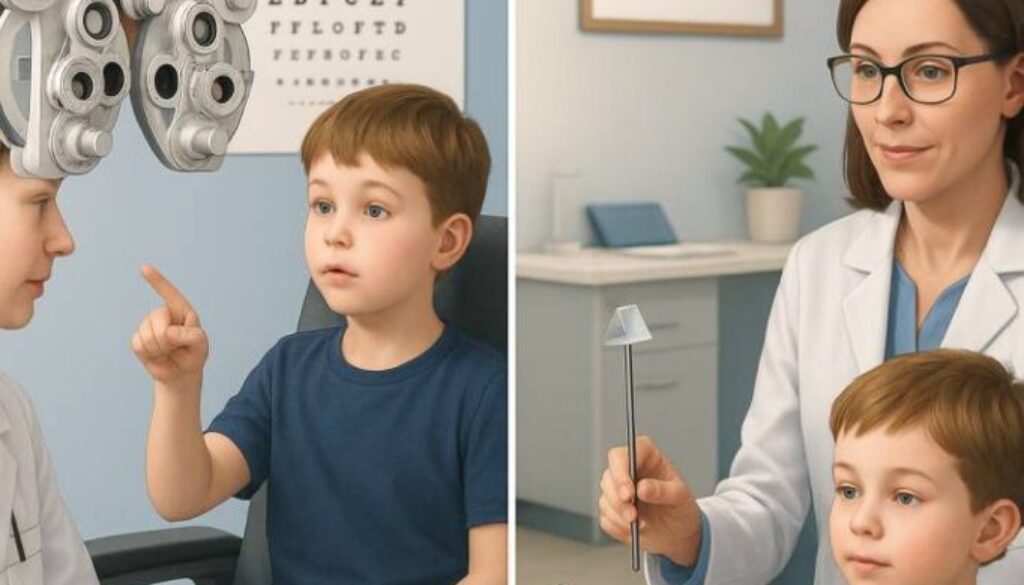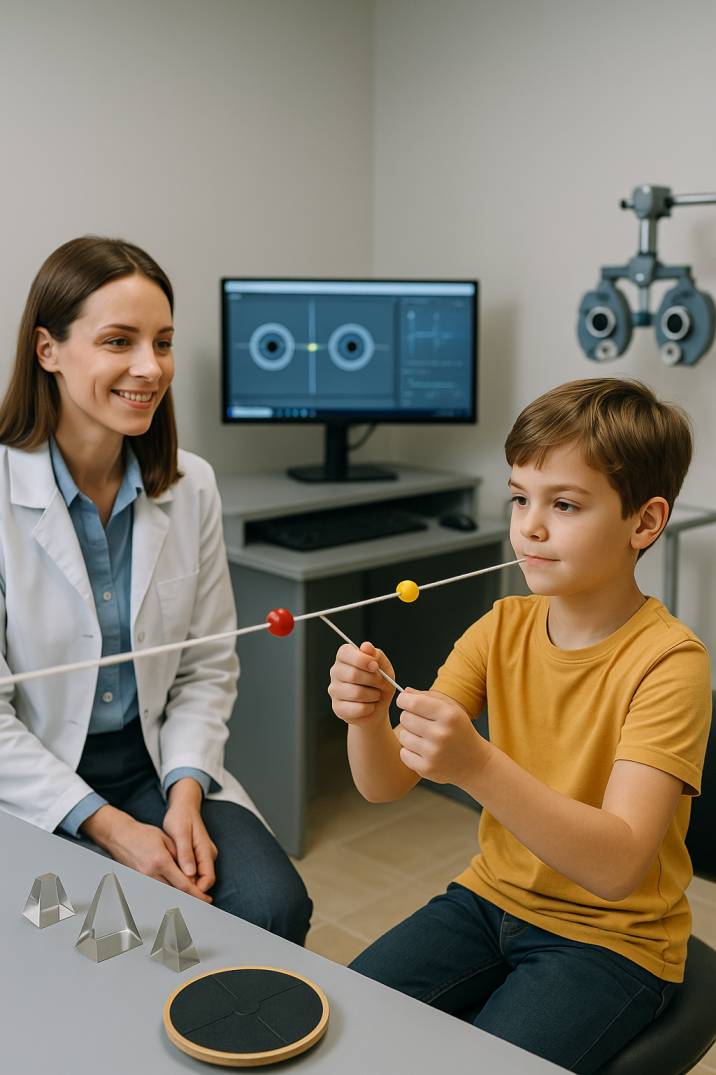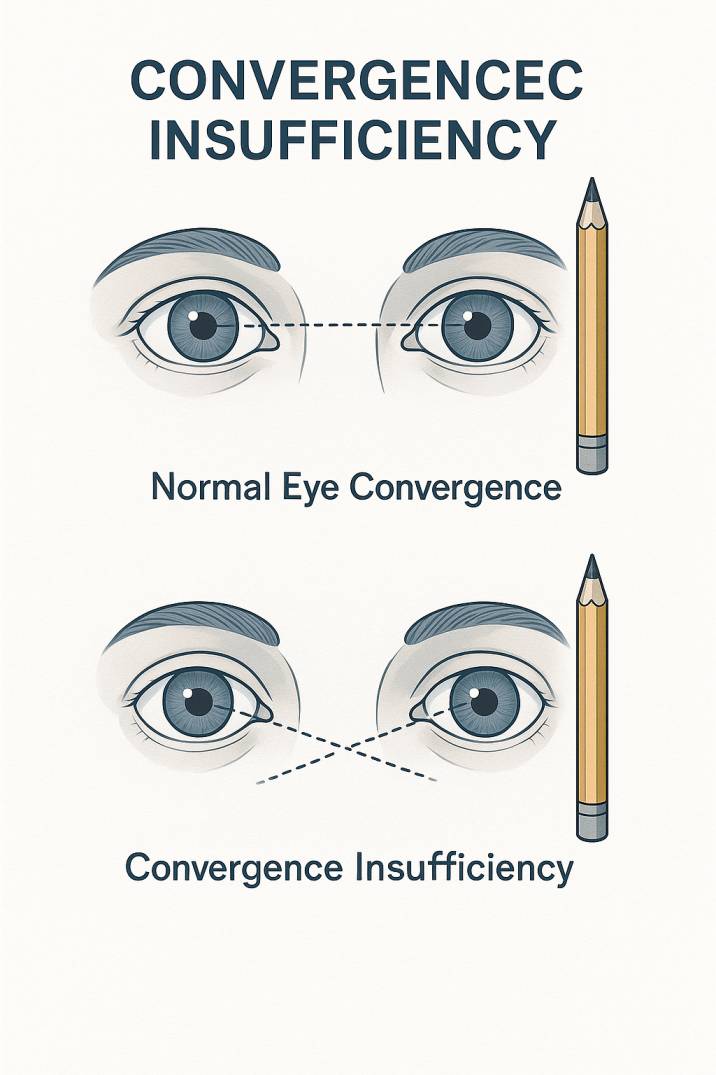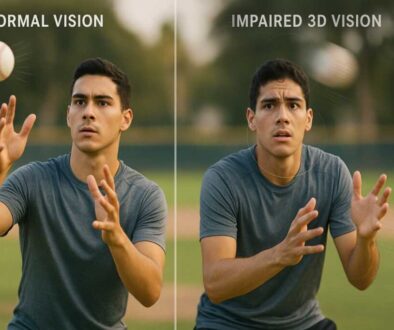Regular Eye Exams vs Vision Therapy: What’s Different?

Understanding the fundamental distinctions between regular eye exams and vision therapy can prove transformative for families addressing learning challenges, visual discomfort, or processing difficulties. This comprehensive analysis examines both approaches, their respective applications, and the evidence supporting their efficacy.
Understanding Regular Eye Examinations
Regular eye examinations, formally known as comprehensive ocular health assessments, constitute the cornerstone of preventive vision care. These evaluations primarily focus on determining refractive needs and assessing overall ocular health status.
Clinical Objectives of Standard Eye Examinations
A comprehensive eye examination addresses ocular health management and visual acuity assessment, typically evaluating the need for corrective eyewear. During these appointments, optometrists systematically evaluate several key areas:
Visual Acuity Assessment: This fundamental measurement determines your ability to discern fine details and shapes at specified distances. The familiar procedure involves reading progressively smaller letters or symbols on a standardized chart positioned 20 feet from the patient.
Refractive Error Evaluation: Clinicians determine the presence and degree of myopia (nearsightedness), hyperopia (farsightedness), or astigmatism requiring optical correction.
Ocular Health Examination: Advanced diagnostic technology, including biomicroscopy and digital imaging, enables a comprehensive assessment of all ocular structures and surrounding tissues.
Intraocular Pressure Measurement: Tonometry screening detects elevated eye pressure associated with glaucoma and other pressure-related conditions.
Diagnostic Capabilities of Regular Eye Exams
Standard eye examinations excel at detecting:
- Refractive errors necessitating corrective lenses
- Ocular pathologies, including glaucoma, cataracts, and macular degeneration
- Diabetic retinopathy and other systemic disease manifestations
- Acute ocular conditions and infectious processes
Limitations of Conventional Eye Examinations
Despite their comprehensive nature, regular eye exams possess inherent limitations. Research indicates that most school-based vision screenings fail to detect the majority of vision problems that significantly impact children’s academic performance. Even thorough comprehensive eye exams may overlook critical visual processing deficits that affect daily functioning and learning capacity.
Vision Therapy: A Comprehensive Overview
Vision therapy represents a specialized, evidence-based treatment approach that extends beyond conventional eye exercises. This therapeutic discipline enhances brain-eye communication and optimizes the functional operation of the visual system. Unlike traditional optometric care, vision therapy addresses how the brain processes and interprets visual information.
The Neurological Foundation of Vision Therapy
Peer-reviewed research demonstrates the physiological effects of specific vision therapy protocols, with studies documenting measurable increases in cortical activity following repetitive vergence training. This evidence establishes that vision therapy produces quantifiable neurological changes in brain function, supporting its scientific basis.
Core Therapeutic Domains
Binocular Vision Coordination: Research identifies 17 essential visual skills required for clear, comfortable vision. Vision therapy systematically strengthens the coordination and synchronization between both eyes.
Ocular Motor Function: Treatment protocols improve the precision and efficiency of eye movements essential for reading, athletic performance, and complex visual tasks.
Visual Processing Enhancement: Therapeutic interventions accelerate the speed and accuracy with which the brain interprets visual information.
Accommodative Function: Specialized training optimizes the eye’s ability to adjust focus efficiently between varying distances and visual demands.
Comparative Analysis: Vision Therapy vs. Regular Eye Examinations
Fundamental Objectives and Scope
The primary distinction between standard eye examinations and vision therapy evaluations lies in their therapeutic objectives. Conventional eye examinations focus on ocular health assessment and visual acuity measurement, determining the need for corrective lenses. In contrast, vision therapy evaluations assess functional visual performance and processing capabilities.
Standard Eye Examination Parameters:
- Visual acuity measurement (20/20 assessment)
- Ocular pathology detection and management
- Refractive error correction and lens prescription
- Basic binocular function screening
Vision Therapy Evaluation Components:
- Binocular coordination and eye teaming assessment
- Visual processing and brain-eye integration analysis
- Functional vision skills for academic and occupational demands
- Identification of underlying causes affecting learning and performance
Diagnostic Methodology and Instrumentation
Regular eye examinations employ standardized clinical equipment, including:
- Snellen charts for distance visual acuity assessment
- Retinoscopes and phoropters for refractive evaluation
- Slit-lamp biomicroscopes for anterior segment examination
- Goldmann applanation tonometers for intraocular pressure measurement
Vision therapy evaluations utilize specialized diagnostic protocols:
- Advanced binocular vision testing with sophisticated instrumentation capable of detecting subtle processing deficits, including equipment that identifies when the brain suppresses input from one eye or fails to coordinate eye muscles for precise fixation
- Comprehensive visual processing and perceptual assessments
- Dynamic eye movement and tracking evaluations
- Functional vision skills analysis for real-world applications
Treatment Modalities and Outcomes
Conventional Eye Examination Results:
- Corrective lens prescriptions for refractive errors
- Surgical referrals for appropriate candidates
- Pharmaceutical interventions for ocular diseases
- Preventive care recommendations for long-term ocular health
Vision Therapy Treatment Outcomes:
- Vision therapy addresses visual processing deficits that extend beyond refractive correction, teaching patients evidence-based strategies for overcoming visual limitations
- Individualized therapeutic exercise programs targeting specific visual skill deficits
- Sustained improvements in visual processing capabilities with documented neuroplasticity
- Enhanced academic performance, athletic coordination, and occupational efficiency
Clinical Indications and Patient Selection
Appropriate Candidates for Regular Eye Examinations
Comprehensive eye examinations are indicated for individuals experiencing:
- Visual acuity changes or refractive symptoms
- Difficulty with distance vision tasks, such as driving or classroom instruction
- Family history of ocular pathology requiring genetic surveillance
- Routine preventive care according to age-appropriate screening guidelines
- Suspected ocular manifestations of systemic disease
Vision Therapy Evaluation Criteria
Vision therapy assessment becomes appropriate when visual processing difficulties persist despite adequate ocular health and optimal refractive correction. Clinical research indicates this occurs when visual problems continue to impact daily functioning despite conventional treatment approaches.
Academic and Cognitive Manifestations:
- Reading comprehension deficits despite adequate intellectual capacity
- Persistent letter or number reversals beyond developmentally appropriate ages
- Compromised reading fluency and academic performance
- Avoidance behaviors related to near-vision tasks
- Frequent loss of place during sustained reading activities
Neurological and Physical Symptoms:
- Chronic headaches associated with visual concentration tasks
- Ocular strain and fatigue disproportionate to visual demands
- Intermittent diplopia or visual disturbances
- Vestibular symptoms, including dizziness during visual activities
Behavioral and Functional Indicators:
- Monocular suppression behaviors (covering or closing one eye)
- Compromised visuomotor coordination affects daily activities
- Athletic performance limitations related to visual-motor integration
- Reduced attention span, specifically during visually demanding tasks
The Evidence: What Research Shows
Scientific Support for Vision Therapy
Office-based vision therapy is an effective treatment for children with Convergence Insufficiency. The Convergence Insufficiency Treatment Trial (CITT), funded by the National Eye Institute, represents gold-standard research in this field.
Key Research Findings:
- Convergence Insufficiency Treatment: A National Eye Institute (NEI)-funded study using multi-center, randomized, double-blind clinical trials showed that for convergence insufficiency (eye teaming difficulty), office-based vision therapy was successful in 73% of patients, with an additional 19% showing improvement.
- Long-term Effectiveness: It was reported that the accumulated cure rate was 72%the, the rate of improvement was 19%, and the failure rate of treatment was 9% across multiple studies evaluating vision therapy outcomes.
- Brain-Based Changes: There are experimental studies showing the physiological effects of specific exercises of vision therapy, and it has been shown that even the cortical activity is increased after the performance of repetitive vergence training.
Conditions with Strong Research Support
Convergence Insufficiency: This common condition affects approximately 7.5% of the population, with prevalence ranging from 2% to 13% in school-age children, depending on the diagnostic criteria used.
Accommodative Dysfunction: A randomized clinical trial of treatments for convergence insufficiency in children. Archives of Ophthalmology 2005 and subsequent studies show significant improvement in focusing abilities.
Amblyopia (Lazy Eye): Patching times for amblyopia can be shortened while still achieving comparable visual improvement when combined with vision therapy approaches.
Making the Right Choice for Your Family
Start with the Comprehensive Assessment
If you’re experiencing visual symptoms or learning difficulties, begin with a thorough evaluation. If you think your child has a vision or visual problem that may be affecting their performance in school or sports, the first step is to schedule regular eye exams to rule out nearsightedness, farsightedness, and/or astigmatism.
Understanding the Complementary Relationship
Vision therapy and regular eye care work together, not in competition. Many patients benefit from both approaches:
- Regular eye exams ensure optimal eye health and correct refractive errors
- Vision therapy addresses functional visual skills that glasses alone cannot fix
- The combined approach provides comprehensive visual wellness
Questions to Ask Your Eye Care Provider
When seeking a vision therapy evaluation, inquire about:
- The doctor’s specific training in developmental optometry
- Success rates for your particular condition
- Expected duration and cost of treatment
- Criteria used to measure progress and success
- Integration with other therapies or interventions
The Cook Vision Therapy Advantage
At Cook Vision Therapy Center, Dr. David Cook’s four decades of specialized experience and international recognition provide families with the expertise needed to address complex visual processing challenges. Specialists who work in vision therapy employ medical knowledge based on the vision problems discovered through the specific exam to determine the relation to symptoms and overall function.
Specialized Expertise Makes the Difference
Unlike general eye care practices that may offer vision therapy as a secondary service, Cook Vision Therapy Center focuses exclusively on vision therapy and visual rehabilitation. This specialized approach ensures:
- Comprehensive evaluation of all visual processing components
- Customized treatment plans based on individual needs
- Advanced diagnostic techniques beyond standard eye exams
- Proven protocols for lasting visual improvement
Family-Centered Care Approach
Understanding that vision challenges affect the entire family, Cook Vision Therapy Center provides:
- Educational support to help families understand their child’s visual needs
- Home reinforcement activities to maximize therapy outcomes
- Coordination with schools and other healthcare providers
- Long-term support for sustained visual development
Taking Action: Your Next Steps
Understanding Financial Investment
Before pursuing vision therapy, it’s important to understand the financial commitment involved. Most vision therapy providers operate as out-of-network specialists, meaning families typically pay out-of-pocket initially and may seek partial reimbursement through major medical insurance if the treatment is deemed medically necessary.
If You Suspect Visual Processing Issues
- Document Symptoms: Keep a log of visual difficulties, including when they occur and their impact on daily activities.
- Complete a Comprehensive Eye Exam: Ensure basic eye health and refractive needs are addressed.
- Seek Specialized Evaluation: If symptoms persist despite good eye health and appropriate glasses, consider a developmental optometry evaluation.
- Explore Treatment Options: Work with qualified professionals to develop a comprehensive treatment plan.
Cost and Insurance Considerations
Insurance Coverage: Vision therapy is generally not covered by standard vision insurance plans. Coverage may be provided through major medical insurance for medically necessary treatments, such as correcting amblyopia in children, addressing convergence insufficiency, or treating post-concussion vision problems. Many vision therapy providers are out-of-network, requiring families to pay out-of-pocket and seek reimbursement.
Typical Costs:
- Initial comprehensive vision therapy evaluation: $300-500
- Treatment programs vary based on individual needs and duration
- Many practices offer payment plans and financing options through programs like CareCredit
The Investment Perspective: While the upfront cost may seem significant, families often find that addressing visual processing issues early prevents more costly interventions later, including additional tutoring, academic support, and potential safety concerns.
The investment in proper visual development pays dividends throughout life:
- Enhanced academic performance and learning efficiency
- Improved sports and recreational activities
- Reduced eye strain and visual fatigue
- Greater confidence in visual tasks
- Better quality of life across all activities
Conclusion: Seeing the Complete Picture
Understanding the difference between vision therapy and regular eye exams empowers families to make informed decisions about their visual health. While regular eye exams remain essential for maintaining eye health and correcting refractive errors, vision therapy addresses the sophisticated visual processing skills that enable us to learn, work, and thrive in our visually demanding world.
For the most thorough eye exams and treatments to address the root of your visual problems, vision therapy exams are a clear choice. When academic struggles, learning difficulties, or persistent visual symptoms impact daily life, specialized vision therapy evaluation may provide the answers and solutions that transform both visual function and overall quality of life.
For families in the Metro Atlanta area seeking expert vision therapy services, Cook Vision Therapy Center offers the specialized expertise, proven results, and compassionate care needed to address complex visual processing challenges. With Dr. David Cook’s four decades of experience and exclusive focus on vision therapy, families can access the highest level of specialized care available in the region.
References and Resources
The information in this article is based on peer-reviewed research and clinical studies. Here are three key scientific resources that support the evidence presented:
1. Convergence Insufficiency Treatment Trial (CITT) – National Eye Institute
Source: Scheiman M, Mitchell GL, Cotter S, et al. A randomized clinical trial of treatments for convergence insufficiency in children. Archives of Ophthalmology. 2005;123(1):14-24.
Link: https://www.ncbi.nlm.nih.gov/pmc/articles/PMC2779032/
Key Finding: This landmark National Eye Institute-funded study demonstrated that office-based vision therapy achieved a 73% success rate for treating convergence insufficiency in children, establishing the gold standard for vision therapy research.
2. Effectiveness of Vision Therapy in School Children with Convergence Insufficiency
Source: Moon HW, Shin SY, Lim HT. Effectiveness of Vision Therapy in School Children with Symptomatic Convergence Insufficiency. Journal of Ophthalmic and Vision Research. 2017;12(2):187-192.
Link: https://www.ncbi.nlm.nih.gov/pmc/articles/PMC5423373/
Key Finding: International validation study showing 72% cure rate and 19% improvement rate among Korean elementary school children, confirming vision therapy effectiveness across diverse populations.
3. Science-Based Vision Therapy – Neuroplasticity Research
Source: Piñero DP. Science-based vision therapy. Journal of Optometry. 2016;9(4):203-204.
Link: https://www.ncbi.nlm.nih.gov/pmc/articles/PMC5030323/
Key Finding: Research demonstrating measurable changes in cortical activity following vision therapy, providing neurological evidence for brain-based improvements in visual processing.
Ready to discover if vision therapy could help you or your child?
Contact Cook Vision Therapy Center today to schedule a comprehensive evaluation and take the first step toward clearer vision and enhanced learning potential.
FAQs
-
Vision therapy focuses on training visual skills, while a regular eye exam checks eyesight, eye health, and updates prescriptions





